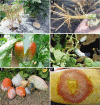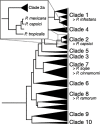The oomycete broad-host-range pathogen Phytophthora capsici
- PMID: 22013895
- PMCID: PMC6638677
- DOI: 10.1111/j.1364-3703.2011.00754.x
The oomycete broad-host-range pathogen Phytophthora capsici
Abstract
Phytophthora capsici is a highly dynamic and destructive pathogen of vegetables. It attacks all cucurbits, pepper, tomato and eggplant, and, more recently, snap and lima beans. The disease incidence and severity have increased significantly in recent decades and the molecular resources to study this pathogen are growing and now include a reference genome. At the population level, the epidemiology varies according to the geographical location, with populations in South America dominated by clonal reproduction, and populations in the USA and South Africa composed of many unique genotypes in which sexual reproduction is common. Just as the impact of crop loss as a result of P. capsici has increased in recent decades, there has been a similar increase in the development of new tools and resources to study this devastating pathogen. Phytophthora capsici presents an attractive model for understanding broad-host-range oomycetes, the impact of sexual recombination in field populations and the basic mechanisms of Phytophthora virulence.
Taxonomy: Kingdom Chromista; Phylum Oomycota; Class Oomycetes; Order Peronosporales; Family Peronosporaceae; Genus Phytophthora; Species capsici.
Disease symptoms: Symptoms vary considerably according to the host, plant part infected and environmental conditions. For example, in dry areas (e.g. southwestern USA and southern France), infection on tomato and bell or chilli pepper is generally on the roots and crown, and the infected plants have a distinctive black/brown lesion visible at the soil line (Fig. 1). In areas in which rainfall is more common (e.g. eastern USA), all parts of the plant are infected, including the roots, crown, foliage and fruit (Fig. 1). Root infections cause damping off in seedlings, whereas, in older plants, it is common to see stunted growth, wilting and, eventually, death. For tomatoes, it is common to see significant adventitious root growth just above an infected tap root, and the stunted plants, although severely compromised, may not die. For many cucurbit fruit, the expanding lesions produce fresh sporangia over days (or even weeks depending on the size of the fruit) and the fruit often look as if they have been dipped in white powdered confectioner's sugar (Fig. 1). Generally, hyphae do not emerge from infected plants or fruit (common with Pythium infections) and all that is visible on the surface of an infected plant is sporangia.
Importance: Phytophthora capsici presents an oomycete worst-case scenario to growers as it has a broad host range, often produces long-lived dormant sexual spores, has extensive genotypic diversity and has an explosive asexual disease cycle. It is becoming increasingly apparent that novel control strategies are needed to safeguard food production from P. capsici and other oomycetes. Considering that P. capsici is easy to grow, mate and manipulate in the laboratory and infects many plant species, this pathogen is a robust model for investigations, particularly those related to sexual reproduction, host range and virulence.
Useful websites: Phytophthora capsici genome database: http://genome.jgi-psf.org/Phyca11/Phyca11.home.html. Molecular tools to identify Phytophthora isolates: http://phytophthora-id.org.
© 2011 THE AUTHORS. MOLECULAR PLANT PATHOLOGY © 2011 BSPP AND BLACKWELL PUBLISHING LTD.
Figures




References
-
- Aragaki, M. and Uchida, J. (2001) Morphological distinctions between Phytophthora capsici and P. tropicalis sp. nov. Mycologia, 93, 137–145.
-
- Birch, P.R. , Rehmany, A.P. , Pritchard, L. , Kamoun, S. and Beynon, J.L. (2006) Trafficking arms: oomycete effectors enter host plant cells. Trends Microbiol. 14, 8–11. - PubMed
-
- Birch, P.R. , Boevink, P.C. , Gilroy, E.M. , Hein, I. , Pritchard, L. and Whisson, S.C. (2008) Oomycete RXLR effectors: delivery, functional redundancy and durable disease resistance. Curr. Opin. Plant Biol. 11, 373–379. - PubMed
-
- Blair, J.E. , Coffey, M.D. , Park, S.Y. , Geiser, D.M. and Kang, S. (2008) A multi‐locus phylogeny for Phytophthora utilizing markers derived from complete genome sequences. Fungal Genet. Biol. 45, 266–277. - PubMed
Publication types
MeSH terms
Grants and funding
LinkOut - more resources
Full Text Sources
Other Literature Sources
Miscellaneous

